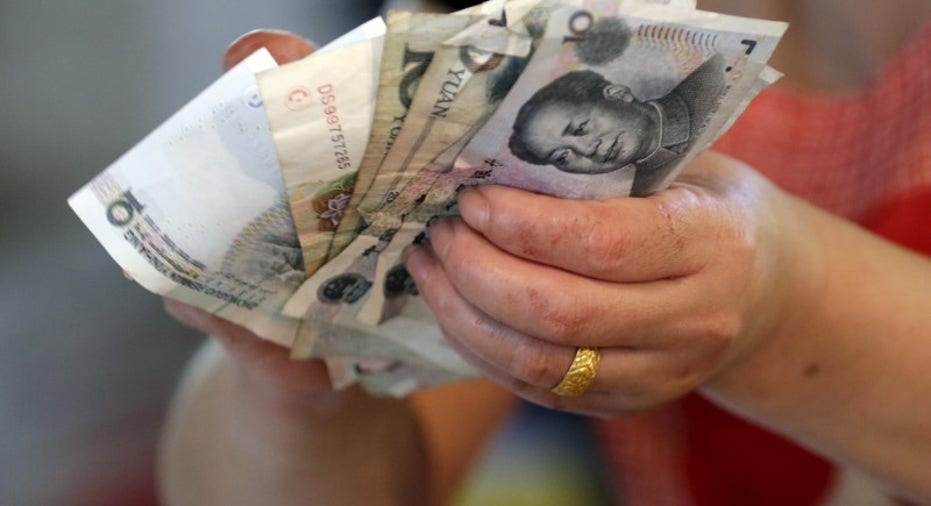Chinese yuan slides to biggest one-day drop since 2015 devaluation

The Chinese yuan dropped 1% against the U.S. dollar Thursday, notching its biggest one-day decline since the Chinese central bank devalued the currency in August 2015.
One dollar bought 6.3260 yuan as of the 4:30 p.m. close for domestic trading on Thursday, marking a 1% decline in the Chinese currency against the dollar from Wednesday. It fell as much as 1.5% earlier in the session, according to Wind Info.
Even with the yuan's sudden fall Thursday, it has surged more than 8% against the dollar in the past year, amid a broad-based pullback for the greenback. In the same period, the euro has jumped 15% against the dollar while the pound is up 11%.
Unlike the unexpected devaluation in 2015, the yuan's move lower Thursday appeared to be driven by market forces rather than official action, traders and analysts said. The currency's slide gathered pace midmorning Asian time following the release of data showing the country's trade surplus had narrowed by more than expected last month, thanks to imports growing faster than exports.
"The yuan's rally earlier this year has been absolutely crazy. Today's data simply unleashed pent-up demand for the greenback," said a Shanghai-based head of trading at a Chinese bank.
Earlier, the Chinese central bank guided the yuan 0.1% stronger than it had the day before, setting the dollar's reference rate at 6.2822 yuan. The currency pair is allowed to trade 2% above and below that level, which is known as the fix.
The yuan's long ascent before Thursday's drop has helped allay criticism in Washington of its currency management. Still, its sudden fall back comes as trade tensions between the U.S. and China have ratcheted up a notch in recent weeks. Data released this month showed the U.S.'s trade deficit in goods with China hit a record level last year.
The Trump administration last month announced it would impose tariffs on imports of washing machines and solar panels, a move widely interpreted as a warning shot against cheap Asian exports. China has in turn this month launched an anti-dumping investigation into imports from the U.S. of sorghum, a crop.
The yuan's strength against the dollar earlier this week had made it an outlier; while it had advanced against the dollar through Wednesday, other global currencies such as the euro and pound had fallen against the greenback. The WSJ Dollar Index, which measures the U.S. currency against a basket of 16 others, has advanced 1% this week.
"A lot of clients, such as importers, had been waiting for a good opportunity to buy dollars and after a large order came in today [from one importer], a lot of them couldn't resist anymore," said a senior foreign-exchange trader at a Chinese bank in Shanghai.
The yuan's drop Thursday eclipsed moves in other major currencies, which is unusual. The euro fell 0.2% against the dollar, while the Japanese yen lost 0.3% against the greenback.
Many fund managers went into the year betting on a stronger yuan, largely fueled by expectations for further dollar weakness. As the yuan started sliding Thursday, those investors may have been caught off-guard, said Zhou Hao, a Singapore-based economist at Commerzbank AG.
"The market was too one-way and too crowded," he said.
In the offshore market, where the yuan trades more freely, the yuan fell 0.4% to 6.3480 per dollar. That meant the yuan's value was weaker in offshore trading hubs such as Hong Kong than in the tightly controlled domestic market, a throwback to the months following the yuan's 2015 devaluation. At that time, foreign investors poured money into bearish bets on the yuan in the offshore market, leading to a wide gap between the yuan's value inside and outside China.
The pace of the yuan's rally in recent weeks had surprised many analysts and investors. At its peak this year on Wednesday, it had advanced roughly 4% against the dollar, putting it around its strongest level since China devalued the yuan on Aug. 11, 2015.
Activity in the options market suggested investors had been getting nervous about the magnitude of the yuan's advance. Investors had been buying options that protect against a fall in the offshore yuan over one month, recently making them more expensive than options that pay out if the yuan rises, according to Thomson Reuters data.
Investors' expectations for swings in the currency pair picked up as the yuan dropped. One-month implied volatility, which is based on options prices, surged to its highest level in more than a year Thursday.
"The appreciation had been pretty fast and furious," said Andy Ji, Asian currency and rates strategist at Commonwealth Bank of Australia in Singapore.
Shen Hong contributed to this article.